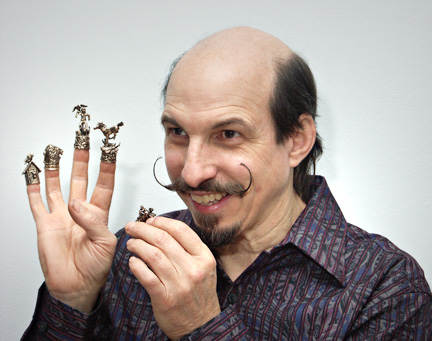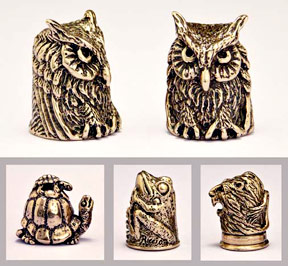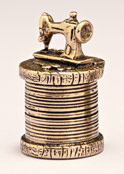All About Riccio Thimbles

In the early 1980’s I became interested in making thimbles. Thimble
making is a skill traditional metal smiths were proud of, and I also wanted
to be a part of this heritage.
My first few thimbles were made for working. I
decorated some of them with my own intricate patterns. My decorations
were attracting
a lot of interest and discussion. The thimble functionality was always
my starting point, but for many collectors it was a secondary consideration.
It seemed that placing more emphasis on the visual statement would be
well received and give me more room to be creative. I began to view the thimble
as an artistic statement.
Embellishing the surfaces was one way of adding visual content. Exploring
a change in shape was also worth looking into. I searched for a theme that
would lend itself to the shape of a thimble and came up with the owl. I
merged the body of an owl with tapered barrel of a thimble to create
a new form
that expressed qualities of both. Then I added detail to further define
the owl concept and texture to enrich the surface. I took great care
to keep
the shape simple and clean. There are no open spaces. Projecting forms,
such as legs and wings are flattened and attached to the surface. You
can do this
yourself by folding your arms or placing them against your side to take
up less space. Simplicity of form is one way to achieve a pure statement.
The
Japanese have perfected this concept in the art of Netsuke carving. In
this same fashion, I made the Bullfrog, Lion, and Turtle thimbles.

One day, a thoughtful customer came up with a suggestion for a new thimble. “Make
a thimble that looks like a spool of thread.” She was right. A thimble
is all about sewing. I went to work on this idea and came out with the Singer
Sewing Machine thimble. I gave her the first one.

About this time, a representative from the Smithsonian’s catalog division found some of the new designs to be interesting. For a few years several of the thimbles made their way into the Smithsonian catalogs and were quite successful. One year, I had a request for a new thimble that would be suitable for the spring catalog. I had a few ideas and submitted them as sketches. A drawing was selected for its use of romantic flowers(roses and forget me nots). I went to work on it and created the Rose thimble.
The National Wildlife Federation had a different focus. The Frog Pond thimble was designed to raise funds for the preservation of wetlands. This thimble took the form of a diorama. The top of the thimble is a raft of lily pads. A frog sits on one of them and a tree stump sticks out indicating that this wetland is new. The side of the thimble is carved as a low relief. It depicts the pond beneath the lilies.
The Rain Forest thimble was another transitional piece. It went just a little
further in expanding the top above the body of the thimble. A toucan and
a tree stand in the open, above the thimble itself, which serves as a base.
Many designs followed using the thimble in this pedestal fashion. The top
assemblies grew ever taller and wider.
I have introduced a lot of ideas into the making of my thimbles. Small changes
in philosophy have given rise to distinct visual styles. I also like to work
on one of a kinds. This is a time to listen to that inner voice, explore
more expansive compositions and press the outer limits of my expertise. The
resulting creations tend to be more art than utility. My subject matter can
vary widely: teddy bear acrobats, seascapes, toys and just about anything
else. Ideas come from many sources and the possibilities are endless, but
there is a down side. Making these exotic forms is very time consuming. As
complicated as these pieces may appear, they all have a “thimble” as
the core form.
At this point I have been making thimbles for more than 25 years. There have
been many experiments and modifications in my approach. Through it all, my
aesthetic sense somehow remains identifiable. If it is a Riccio design, it
looks like one.